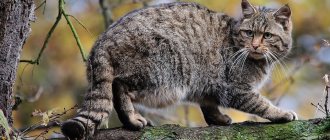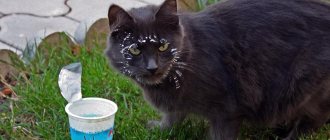- Wild animals
- >>
- Mammals
The Caracal is a cute cat with a streamlined, sleek body, short, golden-reddish fur and distinctive facial markings. These are one of the most beautiful species of wild cats on Earth, also called the desert lynx. Caracals have no spots or stripes, and they have longer legs and a slimmer body than the true lynx.
They are the heaviest and also the fastest of the small cats in Africa. The anatomical adaptations that give the caracal its extraordinary beauty and athleticism are the result of 35 million years of felid evolution.
Origin of the species and description
Photo: Karakal
The caracal's place in the cat family tree is somewhat confusing, but it is believed to be directly related to the serval and golden cat. The caracal's habitat is different from its feline cousins. Servals and caracals are similar in size, however servals hunt in wet habitats while caracals stick to drier areas.
Video: Caracal
Adaptation and diversity of prey in different habitats and areas of different sizes indicate that the caracal is not endangered as a species. The results of phylogenetic studies show that the caracal and the African golden cat (C. aurata) diverged in their development between 2.93 and 1.19 million years ago. These two species, together with the serval, form the Caracal genetic line, which in turn dispersed between 11.56 and 6.66 million years ago. The ancestor of this lineage arrived in Africa somewhere between 8.5 and 5.6 million years ago.
"Felis caracal" is the scientific name used by Johann Daniel von Schreber in 1776, who described the skin of the cheetah from the Cape of Good Hope. In 1843, British zoologist John Gray placed it in the genus Caracal. It is placed in the family Felidae and subfamily Felinae. In the 19th and 20th centuries, several individuals of the caracal were described and proposed as a subspecies.
Since 2020, three subspecies have been recognized by scientists as valid:
- southern caracal (C. Caracal) - found in Southern and Eastern Africa;
- northern caracal (C. Nubicus) - found in North and West Africa;
- Asian caracal (C. Schmitzi) - found in Asia.
The name "caracal" consists of two Turkic words: kara, meaning black, and kulak, meaning ear. The first recorded use of this name dates back to 1760. An alternative name is Persian lynx. The Greeks and Romans most likely applied the name "lynx" to caracals. This name is sometimes still applied to the caracal, but the modern lynx is a separate species.
Appearance and features
Photo: Caracal animal
The caracal is a slender cat characterized by a strong build, short face, long dog-like teeth, tufted ears and long legs. It has brown or red fur, the color of which varies among individuals. Females are lighter than males. Their undersides are white and, like the African golden cat, decorated with many small spots. The fur itself, soft, short and dense, becomes coarser in summer.
The ground hair (the main layer of hair covering the coat) is denser in winter than in summer. The length of the guard hairs can reach 3 cm in winter, but shorten to 2 cm in summer. There are black markings on the face: on the whisker pads, around the eyes, above the eyes and slightly down the center of the head and nose.
A distinctive feature of caracals is the elongated, black tufts above the ears in the form of tassels. There are many theories about their purpose. Tufts can keep flies away from a cat's face or help camouflage themselves in long grass to break up the outline of the head. But, the most common version is that the cat moves its ear tufts when communicating with other caracals.
The legs are quite long. The hind legs are disproportionately high and muscular. The tail is short. Eye color varies from golden or copper to gray or green. Melanistic individuals have been recorded but are extremely rare.
Juveniles are distinguished by shorter ear tufts and blue tinted eyes. The C. caracal subspecies may not differ in phenotype. Females are smaller and weigh up to 13 kg, while males can weigh up to 20 kg. The tail is shortened, but it still makes up a significant part of the total body length. The length of the tail varies from 18 cm to 34 cm. The length of the head and body from the nose to the base of the tail ranges from 62 to 91 cm. Even the most miniature adult caracal is larger than most domestic cats.
Where does the caracal live?
Photo: Caracal cat
The caracal's habitat extends through Africa through the Middle East all the way to India. It is perfectly adapted to the harsh everyday life in the savannah, dry forest, semi-desert, arid hilly steppe and dry mountains. In Africa, the caracal is widespread in sub-Saharan Africa, but is considered rare in North Africa. In Asia, its range stretches from the Arabian Peninsula, along the Middle East, Turkmenistan, Uzbekistan to western India.
The population is disappearing in North Africa, but there are still many caracals in other African regions. Their settlement limits are the Sahara Desert and the equatorial forest belt of Western and Central Africa. In South Africa and Namibia, C. caracal is so numerous that it is exterminated as a nuisance. Asian populations are less numerous than African ones.
Interesting fact: Caracals were once trained to hunt birds in Iran and India. They were placed in an arena containing a flock of pigeons, and bets were placed on how many birds the cat could kill in one jump.
The species inhabits forests, savannas, swampy lowlands, semi-deserts and scrub forests, but prefers arid areas with little rainfall and shelter. In mountainous habitats, this occurs at an altitude of up to 3000 m. A dry climate with limited leaf cover is preferable for the animal. Compared to servals, caracals can tolerate much drier conditions. However, they rarely inhabit deserts or tropical areas. In Asia, caracals are sometimes found in forests, which is not typical for African populations.
In Benin's Pendjari National Park, the movement of caracals was recorded by camera traps. In the Emirate of Abu Dhabi, a male caracal was discovered using camera traps in Jebel Hafeet National Park in February 2020, the first time since 1984. In Uzbekistan, the caracal has only been recorded in the desert areas of the Ustyurt Plateau and the Kyzylkum Desert. Between 2000 and 2020, 15 individuals were spotted alive and at least 11 were killed by herders.
Wild cats: Caracal (31 photos)
We have already discussed a lot of wild cats with you. Here you can look at this list: Jaguarundi (Felis yagouaroundi) Exposing! Usher's cat doesn't exist? Irimoto's cat (Felis Irimotensis) Asian fish cat (Felis viverrina) Black-footed cat (Felis nigripes) Leopard cat (Prionailurus Felis) Dune cat (Felis margarita) Jungle cat (Felis chaus) European wild forest cat (Felis silvestris) Pallas' cat (Felis wiedi) ) Temmincka - golden cat (Felis temmincki) Clouded leopard Cats of Borneo Island Flat-headed cat (Prionailurus planiceps) Rusty cat - the smallest wild cat in the world Chilean cat or Kodkod Pampas cat (Leopardus colocolo) But the list is not exhausted. The caracal (steppe lynx) (Lynx caracal or Felis caracal) is a predator, a mammal of the cat family. For a long time, the caracal was classified as a lynx, since it resembles them in appearance, but after a series of genetic studies it was separated into a separate genus. But still, caracals are closer to lynxes than other cats.
In appearance, the caracal resembles a lynx, only smaller in size, more slender and with a uniform coat color. Body length is 65-82 cm, tail – 25-30 cm, height – approximately 45 cm, weight – 11-19 kg. There are tassels up to 5 cm long at the tips of the ears.
On the paw pads there is a brush made of hard hair, which makes it easier to move through the sand. Well, in general, the size of a caracal does not exceed the size of an ordinary cocker spaniel dog. The fur is thick and short. In color, the caracal is similar to the North American puma - brown-red fur on top, whitish below, there are black markings on the side of the muzzle. The tassels and ears are black on the outside.
Melanistic caracals with black fur are extremely rare. The color of an animal's fur is largely influenced by its habitat and hunting location. For example, the Israeli caracal has a much paler coat than the one living in India, and some Iranian species have black fur and silver tassels on the ears. In some African countries, these animals are called “red cats” for their copper-colored fur, in some – “gazelle cats” for their extraordinary mobility and lightness.
Although the caracal is similar in appearance to a lynx, morphologically it is closer to the puma. Also close to it is the African serval, with which the caracal easily interbreeds in captivity. At first glance, the caracal's face is very similar to that of a cat. The only difference is the large triangular ears, topped with long black tassels. In young caracals, the tassels are almost in a vertical position, but over time their elasticity is lost, and they begin to hang from the ears like ribbons.
Just don’t be impressed by its good looks and small size. Caracals are strong and dangerous predators, far-sighted and experienced hunters, capable of pursuing prey whose weight is twice its own weight. It pierces the throat of its prey with sharp fangs, and holds it with its powerful jaws so that the prey does not escape from its pursuer. The claws and molars are sharp, like blades, with which the caracal cuts prey and separates the meat from the tendons.
The most powerful weapon of this animal can be called its hind legs, muscular and strong, which even an Olympic-level jumper or sprinter would envy. They give the caracal amazing agility. Also, these animals have well-developed hearing, being unusually acute, they see perfectly in the dark. Amazing ears, controlled by twenty muscles, help the caracal hear the noise of an approaching victim when the night is dark all around. There are many hairs inside the ear, which help determine the location of prey as accurately as possible.
The name “caracal” comes from the Turkish word “karakulak” - “black ear”. The explanation for this name is the black back of the ears of caracals. The population of North Africa calls the karcal "Barbary lynx." Caracals are found in deserts, savannas, foothills of Africa, deserts of Central and Asia Minor, and the Arabian Peninsula. Also, these animals can be found, only infrequently, in the desert of Southern Turkmenistan, on the coast of the Caspian Sea (up to the Mangyshlak Peninsula), and occasionally found in Uzbekistan, in the Bukhara region.
Different subspecies of caracals are common in different territories: · In South Africa and Sudan - Caracalcaracalcaracal. · In North Africa – Caracalcaracalalgira. · In Namibia – Caracal caracal damarensis. · In Botswana – Caracal caracal limpopoensis. · In Gabon – Caracal caracal luciani. · In Turkmenistan – Caracal caracal michaelis (Turkmen caracal). This subspecies is endangered, the total number of remaining individuals is no more than 300. · In Ethiopia and Sudan - Caracalcaracalnubica. · In Nigeria – Caracal caracal poecilictis. · From Anterior India to Arabia - Caracalcaracalschmitzi (Indian caracal).
Caracals are active mainly at night, but in winter and spring they can also be found during the day. These animals choose fox or porcupine burrows and rock crevices as their shelters. Caracals can live in one shelter for several years. The territories occupied by males have a large area, while females get smaller areas on the periphery.
The long legs of the caracal allow it to jump up to 4.5 m in length, which it actively uses when hunting, but it cannot run for a long time. An unusually high reaction speed and very sharp retractable claws enable the caracal to grab more than one bird from a flock that has begun to take off. But the main food of this animal is rodents (jerboas, gerbils, gophers), tolai hares, sometimes small antelopes, and in Turkmenistan, goitered gazelles.
Sometimes the caracal preys on porcupines, hedgehogs, insects, reptiles, small predators (mongooses or foxes), and young ostriches. Capable of kidnapping poultry, attacking goats and lambs. Caracals can go without water for a long time; they only need the liquid contained in the prey they eat.
Like the leopard, the caracal hides its caught prey in a tree, away from other predatory animals.
Caracals breed all year round, depending on their habitat; a female can have three partners during her estrus, which lasts six days. Gestation lasts 61-79 days, and 1 to 6 spotted blind cubs are born. The older caracals become, the fewer spots remain on their skin. A week after birth, the kittens' eyes open, and two to four days later they begin to stand up and walk. The cubs grow slowly, with an average daily weight gain of approximately 21 grams.
Until the babies are one month old, the female carries them from den to den every day. Having reached a certain age, usually a year, the young caracal leaves its mother to settle in its own domain. Females settle close to the parental territory, and males go far - from 100 km. Sexual maturity is reached at the age of 16-18 months. Caracals lead a fairly solitary life, with the exception of the breeding season. Occasionally you can find family groups with a small number. The area of an individual male's territory is 95-350 km2, it partially overlaps with the domains of other males; females have smaller territories - 2-112 km2.
Caracals can be easily tamed. In Persia and India, tame animals were used to hunt hares, peacocks, pheasants, and small antelopes. In ancient times, this type of hunting was very popular in eastern countries. In India, the caracal was given the name “little cheetah” or “cheetah for the poor”, since, unlike the cheetah, it was caught and kept by poor people. Nowadays such hunting is rare.
In Africa, mainly in the south, caracals are common animals that are even considered pests. There is a special ritual for hunting caracals: they are lured with devices that can imitate the cry of a mouse or a wounded hare, and they are shot at night from under headlights. In addition, caracals are used in South Africa to drive away birds (mainly guinea fowl) from the runways of military airfields.
The subspecies of caracals found in Asia are much rarer and are even listed in the IICITIES Appendix.
Material taken: Here
What does a caracal eat?
Photo: Caracal desert lynx
Caracals are strictly carnivores. The main components of the diet vary depending on the geography of residence. African cats can consume larger animals such as ungulates, while the Asian cat only eats small vertebrates such as rodents. Livestock are rarely attacked. Although caracals are known for their spectacular leaps to catch birds, more than half of their diet consists of mammals across all ranges.
The main part of the caracal menu consists of:
- rodents;
- hyraxes;
- hares;
- birds;
- small monkeys;
- antelope.
Doves and partridges are of seasonal importance to the species.
In addition, they can sometimes hunt:
- mountain redunks (African antelopes);
- Gazelle Dorcas;
- mountain gazelles;
- gerenuk;
- stenboks;
- African Bustard.
Caracals consume some reptiles, although this is not a common component of the diet. They are unique among cats of their size and can kill prey two to three times their body weight. Small prey are killed by a bite to the back of the head, while larger prey are killed by a suffocating bite to the throat. Prey is usually captured when the caracal leaps using its disproportionately elongated and muscular hind legs.
Fun fact: The Caracal is capable of jumping into the air and knocking down 10-12 birds at the same time!
Before eating its prey, the caracal often “plays” for 5-25 minutes, moving it with its paws. The caracal can even throw a small victim into the air and then grab it in flight. The reasons for this behavior are unclear. Like a leopard, the caracal can climb trees and sometimes stores large prey on branches to return to later. This prevents the prey from being eaten by hyenas and lions, allowing the caracal to make the most of its hunting success. Its large retractable claws and powerful legs give it this climbing ability.
Nutrition
The caracal is only a carnivorous predator. But their diet depends on where they live. In Africa, these cats can hunt ungulates. In Asia, caracals primarily feed on small birds and rodents. There is many evidence of the beautiful jumps of this cat while catching birds. Caracal has its own record. In one jump, he knocks down up to 12 birds on the fly!
Caracal jumping
An interesting list of this cat's diet:
- Different types of rodents;
- Hares, rabbits;
- Small birds and their eggs;
- Small breeds of monkeys;
- Small antelopes;
- Fleet-footed gazelles;
- Bustards in Africa.
These predators can also catch a reptile. Caracals can with a strong blow deprive a victim of life, which weighs several times more than the hunter himself. Due to the fact that the caracal's hind legs are longer than its front legs, it makes huge leaps and knocks large game to the ground.
Interesting: Why did dinosaurs become extinct? Description, photo and video
Caracal - hunting
The caracal climbs trees very well, often storing its prey high on the branches so that it does not fall to numerous predators. This is facilitated by long retractable claws, like those of pets.
Features of character and lifestyle
Photo: Lynx caracal
The caracal is nocturnal, although some activity can be observed during the day. However, this cat is very secretive and difficult to observe, so its activity during the day can easily go unnoticed. A study in South Africa found that caracals are most active when temperatures drop below 20°C. Activity generally declines at higher temperatures. The caracal is mostly found alone. The only recorded groups are mothers and their offspring.
The caracal is an unusually beautiful animal, shaped by natural selection. It is well adapted to various habitats and conditions. Unlike many species, it is able to survive for long periods of time without drinking water, and its amazing jumping ability gives it an almost superhuman nature.
They are a territorial animal and mark the space they occupy with urine and probably feces that are not covered with soil. It is known that one caracal can drive away predators twice its size. Hunting times are usually determined by prey activity, but C. caracal is most often observed hunting at night. In Israel, males have an average of 220 km² and females 57 km². Male territories range from 270–1116 km² in Saudi Arabia. In Mountain Zebra National Park (South Africa), female territories range from 4.0 to 6.5 km².
These areas overlap greatly. Visible ear tufts and face coloring often serve as a method of visual communication. Caracals are observed interacting with each other by moving their heads from side to side. Like other cats, the caracal meows, growls, hisses and purrs.
Health of Caracal cats
Persian chinchilla - silver breed
The Oracal cat has good heredity in terms of health, as well as strong immunity. With proper care, they easily tolerate influenza, plague and other viral diseases.
Despite good health, it is necessary to regularly get vaccinated against the following diseases:
- chlamydia;
- rabies;
- panleukemia;
- calcevirosis;
- rhinotracheitis.
When keeping a caracal, remember that they cannot eat pork. This product contributes to the development of Aujeszky's syndrome, which negatively affects the nervous system and skin.
Like regular cats, caracals must be regularly vaccinated against parasites.
How long do Caracal cats live?
With proper care, an Oracal cat lives 13-16 years.
The cat of this breed is the spitting image of a wild beast
Social structure and reproduction
Photo: Caracal kittens
Before mating begins, females spread urine, the smell of which attracts and notifies the male that she is ready to mate. The distinctive sound mating call is also an attraction method. There have been several different forms of mating systems observed for caracals. When a female is courted by multiple males, the group may fight to mate with her, or she may select her partners, preferring older, larger males.
Mating occurs with several partners over the course of a week. When the female chooses a mate. The couple can stay together for up to four days, during which copulation occurs several times. Females almost always copulate with more than one male. Although both sexes become sexually mature between 7 and 10 months of age, successful copulation will occur between 14 and 15 months of age.
A female can go into estrus at any time during the year. This is associated with the control of the female’s nutrition. When there is a relative abundance of food (which varies among habitats), the female will enter estrus. This explains the peak birth dates between October and February in some regions. A woman cannot have more than one litter per year. The gestation period ranges from 69 to 81 days, and the female gives birth to 1 to 6 kittens. In the wild, no more than 3 kittens are born.
Females invest a lot of time and energy into their young. A tree cavity, abandoned burrow or cave is often chosen for birth and the first four weeks of postnatal development. At the same time, babies begin to play and eat meat. Care continues until the kittens are about 15 weeks old, but they will gain true independence only at 5-6 months.
How to keep a pet caracal
Before getting such an exotic pet, you need to take care of creating acceptable living conditions for a caracal in a country house or city apartment.
Caracals have been tamed by people since time immemorial.
First you need to allocate a place for the wild cat to live. The enclosure must be spacious - at least 20 m2. A scratching post and other accessories necessary for animal play must be installed inside - logs, steps, shelves. If the owner of the caracal lives in an apartment, you need to take care of regular and long-term walking of the animal. After all, desert lynxes are very active cats that need to run and jump.
It is important to remember that it is not recommended to keep the steppe lynx in a house where there are small children. Despite its docile nature, the caracal remains a wild animal with an unpredictable reaction.
Caring for a caracal requires compliance with a number of rules:
- You need to wash your pet as rarely as possible so as not to damage the skin and fur coat;
- The ears and eyes should be checked regularly for contamination;
- The animal’s fur must be combed at least once every seven days;
- It is recommended to remove claws on the front paws using laser technology, and it is better to carry out the procedure in a nursery before purchasing.
To maintain the health of such an exotic pet at the proper level, it is important to properly organize the caracal’s nutrition.
A balanced menu for a domestic desert lynx should include:
- meat dishes - poultry, rabbits, beef;
- fish dishes, including fillets of sea fish at least once every five to seven days;
- raw chicken eggs no more than once every seven days;
- seasonal fresh grass or dry food in winter.
You cannot feed the caracal pork and salty food; sausages and confectionery are prohibited.
For kittens under three years of age, calcium supplements and other vitamin and mineral complexes will be a good addition, which should be selected individually after examination by a veterinarian.
In order to maintain the normal state of the intestinal microflora, once a week you need to add food familiar to predators to the diet of the steppe lynx - small rodents, uncut bird carcasses.
The feeding regimen involves two meals a day. And for males it is recommended to have a “fasting day” every two weeks. During this time, the animal must fast, having access only to water resources. This need is due to the fact that in their natural habitat animals obtain food irregularly, thereby avoiding obesity and other health problems.
The daily portion for an adult caracal is from 350 to 600 g of meat, depending on the age and weight of the pet.
It is also interesting that it is better to give food to the steppe lynx every day at different times, so that it does not get used to the feeding schedule.
Video: caracal at home
Natural enemies of caracals
Photo: Caracal Red Book
External camouflage is the main defense against predators. Caracals prefer open spaces to roost in, so when threatened, they lie flat on the ground, their brown fur acting as instant camouflage. In addition, they move very quickly over rocky terrain, which also helps them avoid large predators:
- Lviv;
- hyenas;
- leopards
However, the listed predators rarely hunt caracals; their main enemy is humans. People kill them for attacking livestock, although this only occurs in some of the animal's ranges, but leads to a large number of deaths (2219 animals in one area). This is particularly the case in South Africa and Namibia, where predator control programs have been introduced. Even with various programs in place, caracals are quickly overpopulating farmland.
It is also attacked for its skin and its meat, which is considered a luxury by some tribes. Although losses from this type of activity are insignificant, since caracal skins are not in demand among other nationalities. The caracal can live up to 12 years in the wild, and some adult caracals live up to 17 years in captivity.
Although caracals are both predator and prey, they are not regularly hunted by lions and hyenas. The greatest impact carcasses have on ecosystems is as population control of other species. They consume whatever is available and use the least amount of energy to catch and kill. In some regions, caracals are one of the few species that kill certain types of prey.
Caring for the health of the steppe lynx at home
Domestic caracals are easy to care for and have excellent immunity. Animals rarely get sick if their owners take proper care.
Regular examination by a veterinarian is the key to the health and longevity of a domestic caracal.
The main health problem may be Aueszky's disease, characterized by the appearance of itchy lesions on the animal's skin and a disorder of nerve endings. Such an illness is possible in case of irregularities in the diet, when the animal is fed pork.
If the owner carefully complies with the requirements for keeping and caring for the steppe lynx, regularly administers vaccinations and visits the veterinarian with the pet, then there will be no problems with the well-being of such a wild cat.
The first vaccination is given to caracals at the age of 3 months, followed by revaccination 30 days later. Pets are also vaccinated against rabies. Vaccines for steppe lynxes living with humans include panleukemia, rhinotracheitis and calcevirosis.
Routine visits to the veterinary clinic should be carried out twice a year.
Inspection should be carried out regularly, despite the animal’s good health. This is also due to the fact that caracals can be carriers of chlamydia, although such an ailment may not manifest itself outwardly.
Caracals are considered long-lived among other representatives of the cat family. The average lifespan of an animal is at least 12–14 years.
Population and species status
Photo: Caracal cat
The actual number of caracals in the wild is unknown, so a thorough assessment of their population status is impossible. They are considered rare or endangered in Asia and North Africa. In central and southern Africa they are considered widespread and are hunted wherever they are found. Poisoned carcasses, which kill many carnivores, are released by ranchers to kill predators.
Between 1931 and 1952, an average of 2,219 caracals per year were killed in South Africa during anti-predator operations. Namibian farmers who responded to a government questionnaire reported that up to 2,800 caracals were killed in 1981.
Fun Fact: An additional threat is severe habitat loss. As people move further into the area, the animals are driven away and the persecution intensifies.
Locals kill caracals to protect their livestock. It is also at risk of being caught in the animal trade in the Arabian Peninsula. In Turkey and Iran, caracals often die in road accidents. In Uzbekistan, the main threat to caracals is killing by herders in retaliation for livestock losses.









